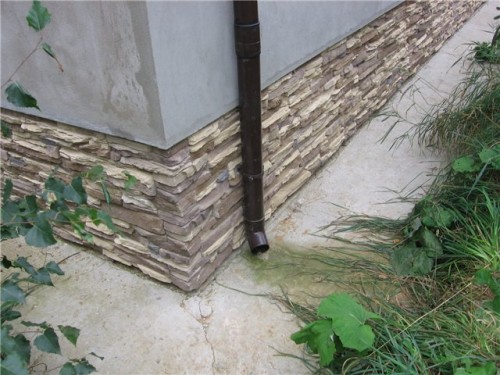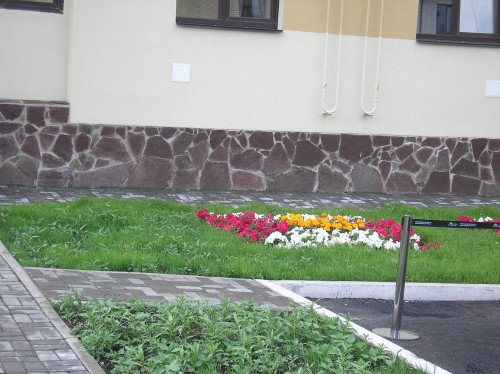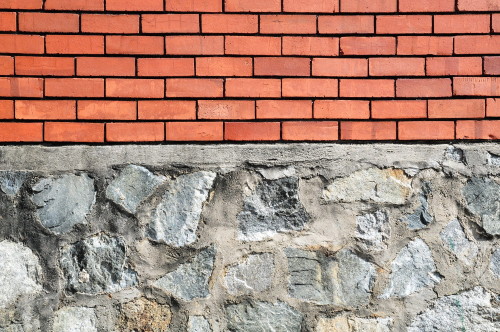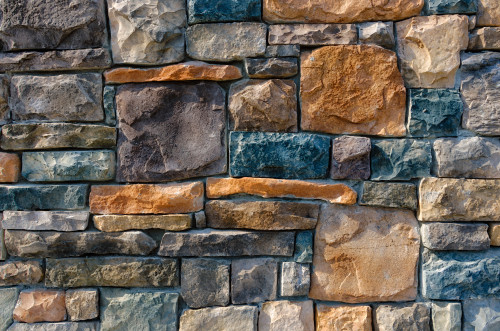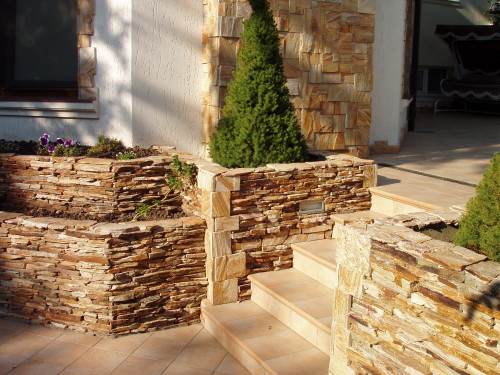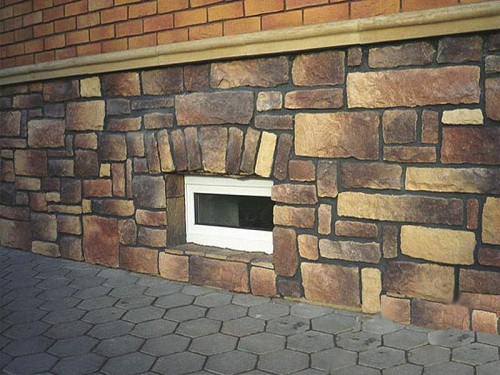
Facing the base of stone Walls,Building materials
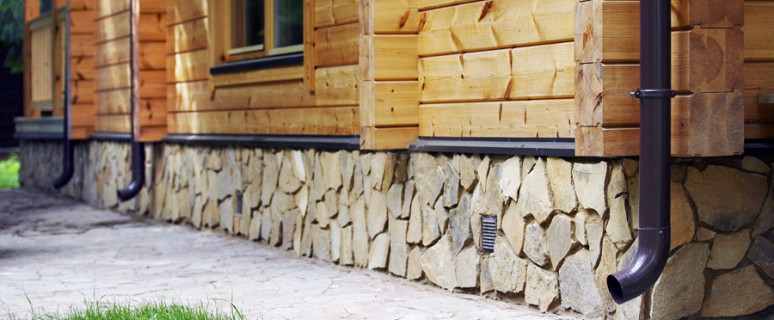
The cladding of the base of the house by stone allows you to solve two tasks: transform the appearance of the building and make it more durable. This exterior decoration is used quite a long time and has a lot of positive feedback. The appointment of the base is to protect the lower part of the facade from mechanical damage. The presence of a finishing coating will make the base more resistant to mechanical and atmospheric influences. Today, various types of materials are applied for this purpose. In this article, we will look at the facing with the help of stone.
Content
Facing features
Facing stone tiles of natural and artificial origin have the same operational characteristics. The difference between them lies in price - natural material is several times more expensive. The decoration of the base stone has the following advantages:
- high strength - this material withstands any loads and at the same time its integrity is not violated;
- resistance to moisture - cladding is not deformed by precipitation or ingress any liquid;
- stone does not absorb pollution, so the surface of the finish does not need special care;
- resistance to high temperatures - the integrity of natural material is not violated even when opening with open fire, and the stone of synthetic origin has a protective coating;
- material is well withstanding low temperatures - natural stone has this quality due to its natural structure, and artificial in the manufacturing process takes place special processing;
- high aesthetic indicators;
- a long period of operation, which is 20 years or more.
For cladding, such types of natural stone are used as:
- granite;
- marble;
- seven;
- sandstone;
- quartzite;
- slate.
All presented types of raw materials have their own characteristic features:
- The most demanded due to its aesthetic indicators is the granite stone. Sandstone is also good popularity.
- The structure of the sewer is represented by pores, so such a cladding needs additional processing of primer or varnish.
- The surface of this material may be different. Grinding base is characterized by minor roughing, but it has a smooth structure.
- The root material has an uneven embossed surface.
- Polished stone passes a special procedure - polishing and it turns out absolutely smooth.
- The most natural surface has a grungy material that is not exposed to any processing.
The stone is characterized by a variety of shapes and sizes. It is produced in the form of a rectangle, square, circle, there are also non-standard forms. The material has a small thickness - 0.5-1 cm. It facilitates the completion of the facing and extends its operational period (heavy stones can be squeezed at a certain period of time).
Finishing base stone. Photo:
Criterias of choice
If you decide to bind the base with natural stones, then before purchase it is desirable to take into account such aspects:
- In the process of acquiring natural material, it is necessary to take into account its value. The most budgetary types of stone is sandstone and a shell. But it should be remembered that their color scheme is quite limited. You can pay attention to a quartzite, which is also characterized by a relatively affordable price. Expensive materials include granite and marble.
- It is not recommended to acquire stones whose surface has many recesses. Cleaning such a facing is quite difficult.
- In addition, it is necessary to familiarize themselves with the certification documentation. Only in this way can make sure that the material has natural origins and does not represent radiation danger.
When choosing an artificial material, the following criteria should be taken into account:
- First of all, attention should be paid to external indicators. In nature there are no same on the shape of stones, so to achieve maximum similarity with natural material you need to select different elements.
- Filler particles in size should be no more than 5 mm. If inclusion fragments exceed these parameters, the operational finishing period will be short. Upon the expiration of a certain time, cracks are formed, after which the material will be folded. In addition, too large particles will not look natural.
- It should be carefully examined by the surface of the material. The inner side should have a small roughness, since it is necessary for the high-quality clutch of stone with the basement.
- It is not necessary to acquire the material, on the outside of which there are defects and irregularities.
- It is also necessary to take into account the quality of painting. Stone must be filtered completely, not just outside. In the process of operation from the facing, a small piece can be broken down, and then if the material surface is painted exclusively, the difference between the inner and outdoor color will be obvious.
- It is recommended to acquire the products of the domestic producer, since such material is most adapted for our climatic conditions.
- To avoid damage during transportation, the stone needs to be properly packaged. To do this, use dense cardboard boxes.
- Determine the amount of material that will be required to work, you can consider such criteria: parameters and shape of the stone, the area of \u200b\u200bthe base and the laying technology.
Facing the base with natural stone
There are two ways to lay stone: jack and with seams. However, the first thing you need to decide on the decoration scheme. At the same time, it is necessary to navigate on roofing and facade finishing materials, the base with them should be harmonized in shape and color. If the house is erected from the brick, in this case stones with clear and smooth lines are better fit. Also note that in the structure of concrete monolith, you can choose asymmetric elements.
Important! It is not recommended to carry out work in the cold season. Under the influence of temperature differences, the material may disappear.
So, for laying you need to prepare:
- concrete composition of the same consistency that is used for alignment;
- a tool for cutting stone, for example, a grinder;
- building level;
- spatulas.
Before carrying out facing work, the surface must be prepared. If the base has a plaster finish, it must be deleted. The exception may be a case when the intermediate thermal insulating layer is planned. Consider the preparation of the base with the laying of thermal insulation:
- The base surface needs to be aligned as much as possible, defects are allowed with a size of no more than 10 mm.
- Next, a layer of plaster or bitumen mastic is applied to the base, since this will allow waterproof the base.
- Then, with the help of dowels, polystyrene sheets are installed. Before mounting, they need to be treated with the composition of quartz primer.
- Next, the grid is installed on the insulation.
If insulation is not planned, the work is performed in the following order:
- Before getting to laying, the surface must be aligned and strengthened. For alignment, a concrete mixture or a plaster composition is used. When choosing plaster, you need to pay attention to the fact that it is resistant to moisture effects, since the work performed will be outdoor. Two types of composition will be required: "Finish" and "Start".
- Concrete solution is prepared on the basis of sand, cement and water. The proportions in which these components are applied depend on the required strength of the mixture.
- Finishing technology has its own characteristics depending on the type of stone. Granite and marble have a lot of weight and polished surface, so it is more difficult to work with them.
Important! If during the finish process it is planned to use two types of material, it should be borne in mind that not all breeds are combined with each other. So sandstone and quartzite, which relate to silicates cannot be combined with limestone, dolomite or marble relating to carbonates. Silicate rocks contain silicon acid that is reacting with carbonate stones. Such contact leads to the destruction of both species.
Material of natural origin has improper forms. This complicates the formation of smooth rows. During the operation, the slabs are assessed as much as possible in the form, while there may be gaps of quite large sizes. The mount can be carried out in several ways:
- with the help of a special composition;
- cement-sand mix;
- mechanically, when the plates are fastened with special fasteners.
Consider the solution for the mortar, as it is the most simple:
- If the stone slabs have a lot of weight, the adhesive mixture should be applied. It is more convenient in the work, but the cement makeup is cheaper. When using it, you must add a plasticizer to the solution.
- Work begins at the bottom of the corner, the direction of laying does not matter much.
- Initially, the solution should be applied to the base, then align with a toothed spatula.
- The stone tile is pre-wetted with water and the mixture is also applied to it.
- Then the stone is pressed against the surface and is adjusted by means of a rubber hammer, as a result of this, the finish turns out more dense. Excess adhesive mass must be immediately removed.
- If the plates are not suitable in size, they can be corrected using a grinder. This uses a disc to work with concrete.
- Next, the next tile is also stacked and the lower row is formed. It is not recommended to place stones too tight, because they will subsequently expand and give out each other.
- You need to get around the whole building, after which you can start by the second row. Thus, the entire base is laid out.
- The top number can be aligned with a grinder if necessary.
- After the end of the work, you should wait until the solution is dry and coat with waterproof varnish. This will make the surface of hermetic and improve the appearance of the facing.
Facing the base with artificial stone
If you decide to bind the building with a synthetic stone, it is worth considering a number of some features. Special attention should be paid to the choice of glue. It is necessary to apply only a quality composition, since the aesthetic form of finishing and strength depends on this directly. The glue must maintain its operational characteristics under the influence of ultraviolet rays, precipitation, low temperature and wind gusts.
So, the necessary for work materials and tools:
- spatulas;
- level;
- grout;
- primer mixture;
- putty;
- rollers;
- adhesive;
- roulette;
- saws and files;
- cord;
- sandpaper;
- metal brush;
- to fill the seams, you need a special pistol.
Before proceeding directly to laying the surface of the base must be prepared:
- To do this, first with a spatula or brush, the base is determined.
- If there are gaps or cracks on the base, they need to be embedded with putty.
- The irregularities that were formed as a result of this are eliminated using emery paper.
- When the putty layer is well freezed, the surface must be applied to the surface. You can continue further work only after it is completely dry.
Stone laying provides several stages. Consider them in more detail:
- First, it is necessary to determine the boundary between the lower and upper finish. Using cord and special lighthouses, you need to mark up. Rows must be symmetrical.
- Before proceeding with the work, the stones should be put on the ground, observing the sequence of laying. This will make it possible to make sure that all the elements are harmonized with each other in size, color and shape.
- Next you need to prepare the adhesive composition. It is important to comply with the recommendations specified in the instructions. Do not prepare a large amount of mixture.
- Stacking should be started from the corner of the bottom row. The adhesive mixture is applied to the base and the opposite side of the stone, after which the material is pressed into the working surface.
- Then, with the help of a rubber hammer, you need to give a stone correct location.
- If the laying technology assumes the seams, there should be a space between the elements in 1.5-4 cm. If necessary, the stones can be cut into fragments.
- All gaps should be treated with composhes for grouting or glue. At the same time, it is necessary to ensure that the composition does not fall on the outer side of the material.
- Then you need to wait until the glue dries, it will take at least a day.
- When the cladding of the base is completed, the surface can be treated with a soil mixture to increase its resistance to moisture.
Thus, the process of cladding the base of the stone is a fairly simple way to protect the base of the building from the negative environmental impact. The materials needed for work are available to a wide range of consumers, and siding itself can be selected from both natural and synthetic raw materials. Works are manufactured in a clear sequence of actions that we led to higher.
The trim technique of the base stone is presented on video:




